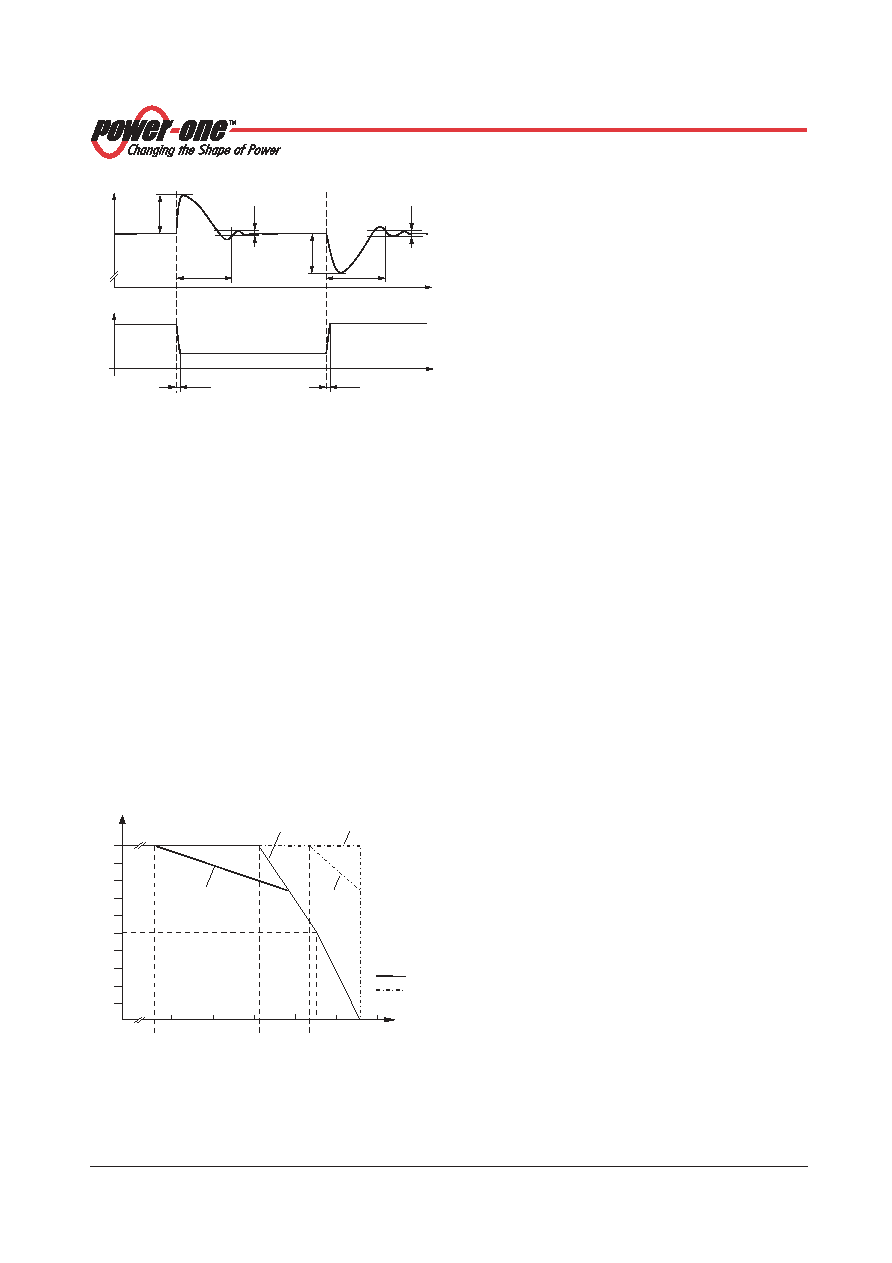- 您現在的位置:買賣IC網 > PDF目錄69114 > PSB153-7IR (POWER-ONE INC) 1-OUTPUT DC-DC REG PWR SUPPLY MODULE PDF資料下載
參數資料
| 型號: | PSB153-7IR |
| 廠商: | POWER-ONE INC |
| 元件分類: | 電源模塊 |
| 英文描述: | 1-OUTPUT DC-DC REG PWR SUPPLY MODULE |
| 文件頁數: | 9/13頁 |
| 文件大?。?/td> | 221K |
| 代理商: | PSB153-7IR |

PSB Series Extended Data Sheet
Positive Switching Regulators (Rugged)
REV. OCT 17, 2003
Page 5 of 13
Fig. 3
Dynamic load regulation.
Io/Io nom
1
Vod
t d
DVo I
t
Vo
0
t
≥10 s
05010
Thermal Considerations
When a switching regulator is located in free, quasi-sta-
tionary air (convection cooling) at a temperature
TA = 71°C
and is operated at its nominal output current
Io nom, the
case temperature
TC will be about 95°C after the warm-up
phase, measured at the
Measuring point of case tempera-
ture TC (see: Mechanical Data).
Under practical operating conditions, the ambient tem-
perature
TA may exceed 71°C, provided additional meas-
ures (heat sink, fan, etc.) are taken to ensure that the case
temperature
TC does not exceed its maximum value of
95 °C.
With an input voltage above 80 V (up to 144 V) or an out-
put current higher than
Io nom (up to Io max) the maximum
allowed temperatures are reduced according to fig.:
Out-
put current derating versus temperature. A check of the
case temperature at worst case conditions (highest input
voltage and highest output current of the application)
against the applicable curve of the figure ensures correct
operation of the system.
0
0.1
0.2
0.3
0.4
0.5
0.6
0.7
0.8
50
60
70
80
90
100
Io/Io max
TA, TC
[C]
0.9
1.0
Vi > 80 V
Vi ≤80 V
Vi > 80 V
05027
46
71
83
TA min
TC min
TA max
TC max
Fig. 4
Output current derating versus temperature
Output Protection
A voltage suppressor diode which in worst case conditions
fails into a short circuit, (or a thyristor crowbar, option C)
protects the output against an internally generated over-
voltage. Such an overvoltage could occur due to a failure
of either the control circuit or the switching transistor. The
output protection is not designed to withstand externally
applied overvoltages. The user should ensure that sys-
tems with Power-One power supplies, in the event of a
failure, do not result in an unsafe condition (fail-safe).
Parallel and Series Connection
Outputs of equal nominal voltages can be parallel-con-
nected. However, the use of a single unit with higher out-
put power, because of its power dissipation, is always a
better solution.
In parallel-connected operation, one or several outputs
may operate continuously at their current limit knee-point
which will cause an increase of the heat generation. Con-
sequently, the max. ambient temperature value should be
reduced by 10 K.
Outputs can be series-connected with any other module.
In series-connection the maximum output current is limited
by the lowest current limitation. Electrically separated
source voltages are needed for each module!
Temperature dependent output current limitation
response
Io L
These switching regulators withstand a continuous input
voltage of up to 144 V DC (120 V +20%) with surges up to
156 V for 2 s. They also comply with LES-DB standard for
VN = 110 V.
Io max is continuously available over the entire temperature
range for an input voltage up to 80 V, or over the whole in-
put voltage range at a reduced maximum ambient tem-
perature of
TA max = 46°C.
For operation at
TA = 46 to 71°C together with an input
voltage between 80 and 144 V the internal thermistor
(PTC) starts to reduce the output current limitation value
Io
L. Under the most extreme conditions this results in a re-
duction of
Io L by 1 A from Io max to Io nom.
The fig.:
Typical temperature dependent output current
limitation response Io L shows the minimum Io L value for
continuous operation with different ambient and case tem-
peratures. Operation at higher ambient temperatures
TA is
possible, provided that the specified case temperature
TC max is not exceeded (short term operation, heat sink,
fan, etc.).
相關PDF資料 |
PDF描述 |
|---|---|
| PSB243-7LIPC | 1-OUTPUT DC-DC REG PWR SUPPLY MODULE |
| PSB363-9LIRC | 1-OUTPUT DC-DC REG PWR SUPPLY MODULE |
| PSB483-9LIRC | 1-OUTPUT DC-DC REG PWR SUPPLY MODULE |
| PSB243-9LIPC | 1-OUTPUT DC-DC REG PWR SUPPLY MODULE |
| PSB153-9LIRC | 1-OUTPUT DC-DC REG PWR SUPPLY MODULE |
相關代理商/技術參數 |
參數描述 |
|---|---|
| PSB153-9IR | 制造商:Power-One 功能描述:DC/DC PS SGL-OUT 15V/36V 4A 144W 7PIN - Bulk |
| PSB155-7IR | 功能描述:SWITCHING REGULATOR 75W 15V RoHS:是 類別:電源 - 板載 >> DC DC Converters 系列:* 標準包裝:5 系列:* |
| PSB155-9IR | 制造商:Power-One 功能描述:DC/DC PS SGL-OUT 15V/36V 5A 180W 7PIN - Bulk |
| PSB156-2 | 功能描述:SWITCHING REGULATOR 90W 15V RoHS:是 類別:電源 - 板載 >> DC DC Converters 系列:* 標準包裝:5 系列:* |
| PSB156-2IR | 制造商:Power-One 功能描述:DC/DC PS SGL-OUT 15V 6A 90W 7PIN - Bulk |
發(fā)布緊急采購,3分鐘左右您將得到回復。